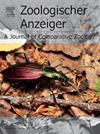Apodemus Kaup, 1829(哺乳目:啮齿目)分布在包括三个土耳其群岛在内的安纳托利亚北部地区的颅骨变异,具有进化洞察力
IF 1.5
3区 生物学
Q2 ZOOLOGY
引用次数: 0
摘要
本研究对来自北安那托利亚、色雷斯、Gökçeada岛、Bozcaada岛和马尔马拉岛39个地区的134个经遗传鉴定(mtDNA cyt b和mtDNA控制区)的Apodemus标本进行了颅骨形态学分析。测定了分布在土耳其的5种姬鼠(黄斑姬鼠、枯萎姬鼠、森林姬鼠、乌拉尔姬鼠、神秘姬鼠)的变异限。这些物种生活在相似的栖息地,因此具有复杂的分类情况,通过遗传鉴定来确定特定位置的变异和标准特征。研究人员确定了马尔马拉海、伊斯坦布尔和Çanakkale海峡、梅雷特河和Çoruh河等地理屏障是否将该物种的种群分开。从古地理的角度对这些推论进行了讨论。发现了Kızılırmak河或生态收缩将黑桫椤分为东西两部分。此外,İstanbul海峡被发现可能导致黄曲霉标本的分离。没有发现Melet河和Çoruh河在物种内造成区别。测定了岛屿种群与大陆种群在岛上分布的短尾姬鼠和枯萎姬鼠的差异。在北安纳托利亚,东西过渡的差异在物种内部被确定,并与栖息地有关。系统进化树表明,木犀草与黄犀草亲缘关系较近。在不同种类的阿姬鼠中发现了腭骨的差异,这种多样性也在不同的地理区域之间被发现。本文章由计算机程序翻译,如有差异,请以英文原文为准。
Skull variation of the genus Apodemus Kaup, 1829 (Mammalia: Rodentia) distributed in the Northern Anatolia region including three Turkish Islands, with evolutionary insight
In this study, skull variations of 134 genetically identified (mtDNA cyt b and mtDNA control region) Apodemus specimens from 39 localities from Northern Anatolia, Thrace, Gökçeada Island, Bozcaada Island and Marmara Island were analyzed based on skull morphology. The limits of variation of five Apodemus species (A. flavicollis, A. witherbyi, A. sylvaticus, A. uralensis, A. mystacinus) distributed in Turkey were determined. These species, which live in similar habitats and thus have a complex taxonomic situation, were genetically identified to determine location-specific variations and standard characters. It was determined whether geographical barriers such as the Marmara Sea, Istanbul and Çanakkale straits, Melet River and Çoruh River separate the populations of the species from each other. These inferences were discussed in terms of paleogeographic reasons. The Kızılırmak River or ecological constriction were found to separate A. mystacinus to west and east parts. Also, the İstanbul strait was found to cause a possible separation of A. flavicollis specimens. The Melet River and the Çoruh River were not found to cause a distinction within the species. Differences between island populations and mainland populations were determined in Apodemus slyvaticus and A. witherbyi distributed in the islands. Differences in the East–West transition in Northern Anatolia were identified within species and related to habitat. Phylogenetic trees suggested that A. sylvaticus is nearly related to A. flavicollis. Differences were observed among Apodemus species in the palatine bone, and this diversity was also detected between geographic regions.
求助全文
通过发布文献求助,成功后即可免费获取论文全文。
去求助
来源期刊

Zoologischer Anzeiger
生物-动物学
CiteScore
2.80
自引率
7.10%
发文量
75
审稿时长
>12 weeks
期刊介绍:
Zoologischer Anzeiger - A Journal of Comparative Zoology is devoted to comparative zoology with a special emphasis on morphology, systematics, biogeography, and evolutionary biology targeting all metazoans, both modern and extinct. We also consider taxonomic submissions addressing a broader systematic and/or evolutionary context. The overall aim of the journal is to contribute to our understanding of the organismic world from an evolutionary perspective.
The journal Zoologischer Anzeiger invites suggestions for special issues. Interested parties may contact one of the editors.
 求助内容:
求助内容: 应助结果提醒方式:
应助结果提醒方式:


